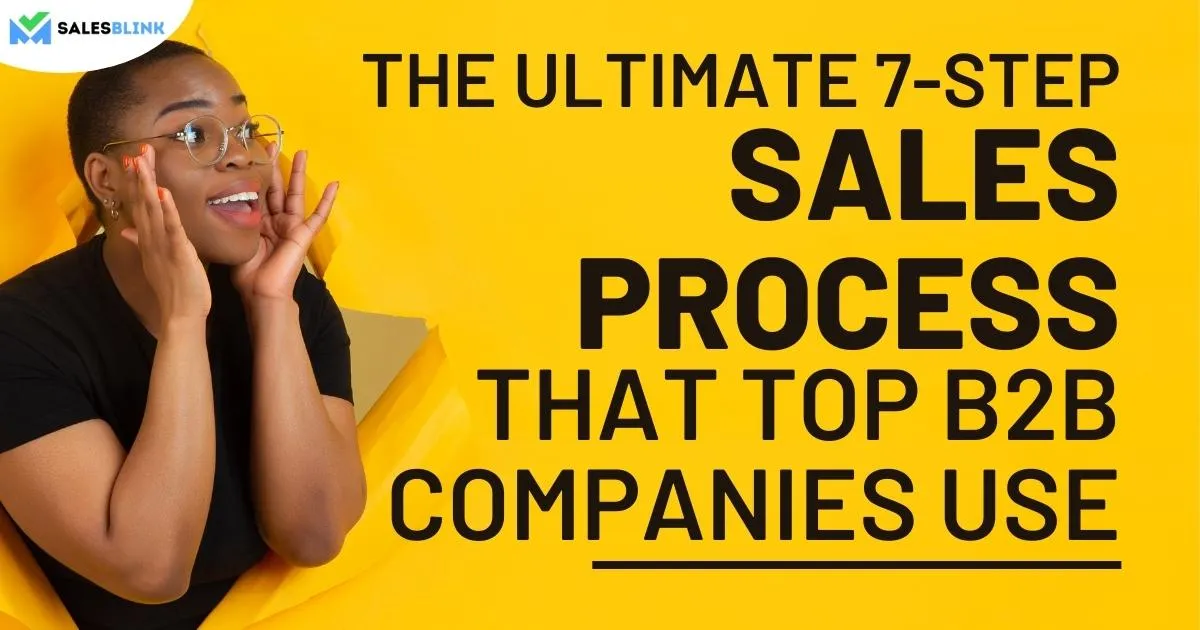Sales is not just about “how can we help you?” or “this is our product” with an affiliative smile. With the upsurge in technology, the whole sales process has changed and has incredibly impacted both salespeople and buyers. There is an increase in the use of sales enablement tools by 567%
Nevertheless, regardless of your industry, you have to follow basic sales strategies to close a deal. Jotting down a process can ensure that you are following a consistent method to transform leads into sales.
For instance, when you first meet a person, you don’t ask them to marry you! First, you get to know the person and then understand them. Go out for some more time, and then you come into a relationship when you know it’s a match. The sales process is the same!
That said, do you know about the sales cycle and how it can help your business? Well, if you don’t know or know very little about it, we have done the raincheck for you. There’s everything from scratch about the 7-step sales process with examples.
Let’s start.
Table of Contents
What Is A Sales Process?
A sales process is a laydown of steps that a salesperson follows to take a prospective buyer from the initial stage to the last stage to close the deal.
In a nutshell, these are the magical steps that will convert a potential prospect into a client. It is like a roadmap you lay for your sales team to close the deals.
Sales Process vs Sales Methodology: What’s The Difference?
There is a difference between the sales process and sales methodology. They are related but are quite distinct.
1. Sales process
A sales process refers to actions the sales reps follow to close a deal with a new customer.
2. Sales methodology
A sales methodology is the framework that helps support the sales process and practices. It refers to the philosophy used by the sales team.
Following are the top 5 most used sales methodologies
a. Challenger sales methodology
This sales approach requires the seller to learn the prospect’s business, customize their sales technique by keeping their needs and challenges in mind.
b. Solution selling
Here, the focus is only on the customer’s pain points.
c. The Sandler Selling System
According to this system, the sales rep and the prospect are both involved in the process of sales.
d. Consultative selling
Here, the sales rep becomes the prospect’s advisor and wins their trust.
e. Inbound selling
This sales methodology is about offering tailored content to draw prospects towards the product or service.
Why Follow The 7-Step Sales Process?
Your degree in sales can take you nowhere if you don’t know the sales cycle basics. Of course, implementing new ideas and innovations can enhance the whole process, but implementing all the basics will make all the difference.
According to a Harvard business review study in 2015, B2B companies that followed a formal sales cycle experienced a hype of 18% in their revenue.
There are various benefits of following a 7-step sales cycle, and I have mentioned some of them below:
a) Lays down a clear path
Without having a clear vision right from prospecting to making a sale, it can lead to failure. With the absence of proper sales, structure prospects can turn down the most profitable deals.
b) Gives predictability
A repeatable sales cycle gives your team a roadmap to win deals. Having an accurate sense of the winning rate allows you to forecast how many sales you can close from a given number of leads at a particular time. Read more about sales forecasting methods.
c) Helps in filtering the qualified leads
With a well-structured sales cycle, your sales team will effectively filter out the low-potential leads. They will identify the prospects who are willing to purchase the service/product. Investing time in high-quality leads decreases the time and efforts wasted; it also shortens the sales cycle.
What Makes A Strong Sales Process?
For a process to be successful, there are specific points that you have to focus on, and they are the following:
1. Has to be customer-centric

The focus has to be on the customers or buyers as they are well-aware and have more options in front of them in this modern age.
2. Must be clear

Each step of the process has to be well-understood and clear.
3. Should be easy to replicate and predict

All the sales reps must follow the steps without getting confused. The outcome of each step should be predictable.
4. Has to focus on the goal

The process of sales should help you meet the sales goals, such as help in increasing the growth of revenue.
5. Should be easy to measure

It must be easy to measure the activities. Only after measuring the outcomes can you find out how successful you are and where you need to improve.
6. Must be easy to adapt

The process of sales has to be such that it can adapt itself to the advancing technology and new sales operations. They should be flexible to change with the changing times.
If the above elements are present in your process, there are higher chances of success.
The 7-Step Sales Process
Here are the steps of a process of sales,
1) Prospecting: Finding your leads
Prospecting is the very first step of the sales process; therefore, don’t rush into it. Take your time and research the industry.
Almost 40% of salespeople find prospecting the most challenging part of the process, followed by closing and qualifying leads.
Prospecting involves researching sites or asking for a referral to those who might be interested in your product or services.
Don’t you have any idea of how you can research your sales industry?
Don’t worry; I have broken it down into three steps:
a) Create an ICP
ICP is the acronym for Ideal Customer Profile. ICP is used to define the environmental, firmographic, and behavioral attributes of accounts that are anticipated to be the company’s most valuable customers. You can start by creating ICP as it can give you a focus point and know more about your ideal customer.
b) Identify convertible leads
Once you are done with your ICP, you can jot down a database of potential leads that are more likely to convert.
c) Initial Filtering
Even though you have got a perfect ICP, you will still need to set a bar to qualify the leads. The key factors you can consider are:
–Budget
–Timing
–Requirement
–Decision-maker.
Rest, if you want, you can add more qualifiers.
2) Approach: Establish Contact
Now that you are done with all the filtering processes, it’s time to reach out. You need to establish a good relationship with the customer.
You can reach out to the prospects by:
a) Going for the best method
You have to find out what is the best way to communicate with your prospect.
You need to know whether they are available on social media, or you can directly reach them via emails or calls. It can also be a face-to-face meeting. You can also use SalesBlink’s meeting scheduler.
There will be times when you will only have their address; in such cases, you have to connect with them via the old-school postcard method.
b) Effective communication
Will you invest in something that is offered to you by a total stranger? Well, no one does! Therefore don’t try to make a sale during the first conversation.
Use the first conversation to introduce yourself and what you can offer them or how your services can benefit them. They say you only get one chance to create a compelling first good impression! Please don’t waste it because it is your only chance.
You can win the prospect’s heart by giving them a gift when you start interacting with them. Get the person interested in you by asking a relevant question. Give freebies like a sample or a free trial so that they can gauge your product or service.
3) Research and Qualify
It is the step in the process of sales where you need to learn more about your prospect. You have to understand their challenges and goals. Also, make sure that during this process, you are reaching out to the decision-maker.
This step allows you to establish how your services can help them.
You must find out placing which product or service in front of the prospect will be the best.
For instance, you are a bespoke software provider. Let’s say your prospect is facing issues in generating online sales.
First, you have to know the neck-deep pain points and why it is happening.
Then you have to offer personalized feedback and tell them how you can help them. This step can improve the likelihood of closing the deal.
4) Build Trust
Now it’s time to prove to your prospect that only your services can help them. Make your point and educate your customers about the benefits, industry, and everyday challenges. While you are building the trust, you are trying to show your prospect that you are reliable.
During this process, you can find out prospects interested in your services and others who are not ready.
5) Provide a solution
Till here, you were only focusing on the prospects. Now, as you are acquainted with them and learned about their needs, it’s time to make the best offer.
You have to keep your offer:
a) Relevant: So that they don’t feel it is something out of the blue.
b) Targeted: You should only tailor them as per requirements.
c) Personalized: They should know you are addressing their problems, not somebody else’s.
You can customize your offers based on the challenges, budget and long-term association.
6) Handle the objections
It is doubtful to come across prospects who don’t have objections to your proposal. You have given an offer now the ball is in your prospect’s court. The most common complaints are the pricing, contract terms, deliverables, and the list can go on. Read our guide on how to overcome sales objections.
That is why handling objections have to be a full-fledged step in a sales process. You have to listen to the problems the prospects face and address them as soon as you can.
It is best to take the prospects on a call and then patiently justify and empathize with their concerns.
For instance, your prospect is having issues with the pricing. Break down the pricing for them and let them know why you are charging the particular amount and the services you will offer.
Dropping out of the process because of rejection will not help you succeed.
The point is that you have to handle the objections and get rid of prospective customers’ concerns. That is what differentiates a good salesperson from a bad one. You mustn’t give up in the face of adversity.
7) Close the deal
Once you have crossed all the hurdles, pat yourself on the back! You have done a fantastic job because it is tough to reach the final stage. In the closing phase, you will be at the final step of closing the deal. You will be sending a proposal of a quote and may need to negotiate a bit and get the necessary approvals from the decision-makers of the client’s organization.
Not all closing attempts are successful and if it does fail, you can request your prospect for a referral or choose to engage with the prospect later on. Know more about sales engagement tips.
Does it mean that your work is done after closing the deal?
Simple answer: No.
Why?
Because you still need to follow up with your newly acquired customers.
Your newly turned customers can be beneficial to you. You have to follow up with those customers who have purchased your product or service, hoping for repeat business and referrals.
Reports say that retaining a customer is 6-7 times less costly than gaining a new one.
It directly means that having a friendly relationship with existing clients can go a long way in giving your sales a boost. You should focus on nurturing the customers by keeping them informed about your new products and services. Also, don’t forget to ask them for their valuable feedback from time to time.
How To Create An Effective Sales Process?
You can create an effective process for your sales team by putting in a little extra effort,
Take a look at how you can create a process that works and also improve the process that exists,
1. Understand what your sales team is currently doing
The sales process has several stages, and each stage has certain tasks that each sales rep follows to take a prospect forward from one stage to the next.
To create an effective process, you must find out what the sales team is doing to convert prospects. Find out the strategies and sales techniques they use to be a part of the process you are building.
2. Remove activities that are not effective
When you have a defined process, it is easier to determine what actions yield results and which do not. Once you get to know the actions that enable the movement of prospects from one stage to the next, you can remove the ones that hamper progress.
3. Help sales team stay on course
Let the process work as a GPS that provides help to stay on course. Reps would know where they presently are and how far they are from the next milestone. They would know when to make the next move and tweak their course.
4. Make use of sales talents
Creativity is always welcome, and you should encourage talents to hop from one stage of the process to another. Creating strategies for social media, curating sales pitches, and writing cold emails need not have hard-and-fast rules. Let talent come to play here.
5. Understand the customer’s perspective
Be customer-centric while creating your process of sales. It should be easy to adapt to the needs of the customer. You have to keep the customer in mind while building the process. You can determine the different target audiences, how different their buying patterns are, are their expectations at each stage of the process and how to sell to them.
6. Focus on building relationships
Prospects like to interact with businesses that give them special treatment rather than just being another number. They want to build long-lasting relationships, and you should fulfill their desire.
Listening actively, showing genuine interest, building trust and following up can help develop deeper bonds with prospects.
7. Find the root cause of stalled deals
It is easy to find out the root cause of stalled sales with a process of sales. You can find out whether the steps are working or not and how many of them you can remove. A process can help you identify what you achieved and what you did not do, along with how it got done or how it did not
8. Bring in qualified leads
Having a clear process of sales can help you do away with leads that are less likely to convert into paying customers. You can concentrate on those who have a higher potential to convert. Identifying qualified leads right at the start of the process will reduce the length of the sales cycle and make it targeted.
Sale Process – Common Mistakes
When you create a process, you may commit a few mistakes. We have listed them here so that you can avoid them and improve the process of sales,
1. Not documenting your sales process and making the sales team practice it
It is important to identify actions that help move prospects from one stage to another in the sales process. If you don’t do this, the sales team is possibly unable to understand exactly what is yielding results and what is the bottleneck. This way, you may not get desired results.
So, after you define your process, document it and share it with the sales team. Practice it well with role-play exercises so that each sales rep is well-versed with each process step.
2. Sticking to just one sales methodology
It is better to try the new and emerging sales methodologies rather than just sticking to one. You can combine the best of the most well-known methodologies and use them for your benefit. It is essential to stay updated because buyers’ needs and your business change with time. Using different approaches and methodologies is thereby crucial.
3. Not remembering that the process is always evolving
You mustn’t forget that the process of sales is forever changing and cannot be completely perfect at any point in time. You constantly have to make changes to the process. Do connect with the sales reps to find out issues or red flags. Let building the process be a continuous process.
4. Keeping sales plays unaligned with the process
Creating a sales process will be of no use if you don’t align sales plays with it. They are repeatable actions that reps can use at every step of the process. You should write down the plays each rep should perform at every stage for future reference. Try to keep them in a shared location so that the whole team can refer to them when needed.
5. Not having marketing on the same page
The marketing team must know what the sales team is doing. Right from which market segment is promising to which of the prospects converted, the marketing team has to know everything to provide the right kind of support.
6. Keeping the focus on closing deals
You may say that sales are all about making sales, but you must not forget to provide value to the prospect first. It holds true even if the prospect is not showing signs of making a purchase. It would be best if you did not stop providing value no matter the situation. The aim should be to help solve the prospect’s pain points. The sales process has to be much beyond hitting sales targets.
7 Step Sales Process Example
Here is a 7-step sales process example for a B2B company:
Got a lead
1. Found the contact details of the decision-maker of the company
2. Got the approval of the decision-maker in presenting a product demo.
3. Offered a trial period during which the sales rep stayed in touch with the potential customer. Re-emphasized the importance of the service for the prospect’s company.
4. Closed the sale with the decision making authorities.
5. Went through the approval process involving other decision-makers in the company.
6. Got approval and booked the sale.
After closing the deal:
1. Followed up with the customer to make sure that the service worked well.
2. Start prospecting other systems of the same company to use the service.
3. Got referrals and began prospecting those companies.
Build An Effective Sales Process!
With consumer behavior and marketing algorithms changing with lightning speed, it is essential to adopt a 7-step sales process that helps you convert the leads.
The sales process steps you saw above are the basic ones that every process usually has. You are free to tailor them based on the nature of your product or service and your target audience. You can remove the ones that are not needed and get started with your process.
Moreover, you also have to take the technological advancement and increase customer awareness while preparing your template for sales reps to follow. It should be easy to understand and work on. You must not leave any room for confusion, or the result will not be as you had expected it to be.
With the right strategies and knowledge of the sales cycle, you can take your sales skyrocketing.
FAQs
A sales process is a laydown of steps that a salesperson follows to take a prospective buyer from the initial stage to the last stage to close the deal. It helps convert a potential prospect into a client.
A sales methodology is the framework that helps support the sales process and practices. It refers to the philosophy used by the sales team to sell to prospects.
Your degree in sales can take you nowhere if you don’t know the sales cycle basics. Of course, implementing new ideas and innovations can enhance the whole process, but implementing all the basics is worth it.

Leave a Reply